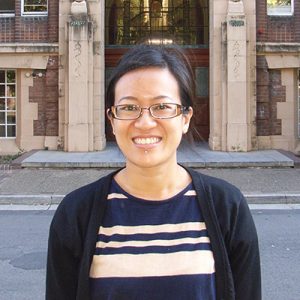
Secondary progressive multiple sclerosis (SPMS) is characterised by worsening physical disabilities, and increasing difficulties with thinking and memory, that diminish quality of life and capacity to work.
Remyelination, the process by which damaged fatty sheaths surrounding nerves are repaired, plays a critical role in remission and recovery from the neurological symptoms that characterise MS. However, in SPMS there is a progressive failure of remyelination, resulting in lesions in brain regions that are associated with specific symptoms and recurring relapses. This contributes significantly to the eventual accumulation of irreversible disability.
There are currently no effective therapies for SPMS. In this study Dr Ly will seek to address this problem by identifying potential therapeutic strategies for SPMS through the discovery of the molecules that underpin remyelination and its failure in MS.
Working in the laboratory of Dr Michael Barnett, with expertise in both MS neuropathology and proteomics, Dr Ly will be ideally placed to successfully identify and validate these key molecules.
Proteomics is the study of all the proteins that are activated and deactivated in a particular biological situation. Combined with sophisticated statistical ‘bioinformatics’ techniques, it represents a high-throughput, rapid tool to identify ‘the needle in the haystack’ – the key proteins from a pool of several thousand that are unique to that situation.
Dr Ly has recently developed methods that enable the effective use of proteomics in archived post-mortem MS brain and spinal cord tissue. She will now examine the differences in the molecular ‘signatures’ that characterise remyelinated lesions and chronically demyelinated lesions in MS tissue.
The new molecular data generated by this study will provide a framework for the discovery of novel drugs that promote regeneration in MS.
The first stage of this project involved the classification of tissue taken from the brain and spinal cord of people with MS into different categories of lesions. Using strict pre-defined criteria, Dr Ly examined the brain tissue by microscope and divided lesion tissue into groups with chronic lesions, early remyelinated and late remyelinated zones, recently active and active lesions and also examined the tissue immediately surrounding the lesions.
Dr Ly has successfully characterised 53 regions of tissue under the microscope, taken from three cases of MS.
Analysis of the proteins in these areas of tissue identified 852 individual proteins. When the areas from the lesions were compared with the areas immediately adjacent to the lesions, 156 proteins were found be present in significantly different amounts. Analysis of the functions of the proteins found 33 proteins were ‘representative’ and that they were involved with 15 key functional networks. These functional networks were associated with cell structure and cell death, and the inflammatory response, which may influence the remyelination process in lesions.
Seven of these proteins were then subjected to a range of follow-up analyses to characterise them further in MS tissue. Dr Ly used a number of cutting edge techniques to validate the differing amounts of protein in the tissue.
These experiments will allow her to determine the location of these proteins in relation to cells in the neurological tissue and other components such as nerve fibres and myelin. This included fluorescent and molecular tagging of proteins under a microscope, and also
another method, known as selective reaction monitoring using mass spectrometry, to examine these proteins within chronic and late-remyelinating lesions. Dr Ly was able to confirm the abundance changes for two of the proteins. The proteins, STMN1 and GSN, may be involved in remyelination. STMN1 interacts with microtubules, which are structurally important to myelin. GSN is involved with a number of cellular processes and may be involved with myelin formation during brain development. Dr Ly’s work is one of the first studies to generate protein data sets from remyelinating MS tissue that also encompasses comparisons with surrounding tissue. She has also developed a number of technical methods to successfully analyse frozen and paraffin embedded tissue.
Updated: 7 May 2015
Updated: 05 January, 2012

